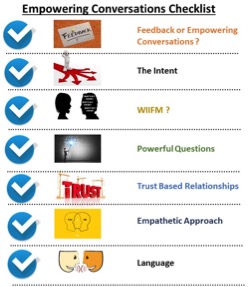11 Jun From Feedback to Empowering Conversations- A Checklist for Leaders
In the modern day corporate world one of the most dreaded and hated words is feedback. It’s interesting that it’s like that bitter pill which nobody likes, be it the receiver or the giver.
In my over two decades of corporate experience as a learning & development professional, I see this as the weakest link in our effort to build high performing teams. It’s imperative that it’s high time that s to address this situation.
The question is why is this the weakest link in first place?
Here are the three reasons why I consider this as the weakest link to build high performing teams:
1.The culture: In Indian culture, we have this hesitation to talk about the developmental areas of each other and ourselves. We are not very comfortable in talking about this. We somehow see talking about development areas as a blemish. Also, on the other hand, we are also not very vocal about the strengths of each other. So, we operate on extremes. One side of the extreme is that we will be quiet about the subject, with the person concerned, but on the other hand, talk about it with everybody else.
2.Language: The other extreme is that there are times when we tend to explode. And when that happens we use a word which is not very empowering. In some cases, the language used in feedback is quite hurting which results in demotivation and hence underperformance.
3.Problem-focused: Also, most of the times, as leaders we are focused on the problems and not the solution. That focus, lead us to choose a la at times, make the recipient uncomfortable and defensive.
Overall, this adds up to a culture which is not conducive for trust, growth, and development.
So, how should we go about bring in this transformation?
Here is a checklist of seven simple pointers that can bring forth a change in our Learning culture
- Replace the word “Feedback” – Over a period, the word feedback has become synonymous to an unpleasant conversation. Leaders perceive it as a tough talk around the area of developments. I feel that for anything to change, we need to change the nomenclature first. The purpose of feedback, be it developmental or positive is to empower an individual to help them perform better. Hence we can replace the word feedback with “empowering conversations” as this will make the entire conversation more acceptable. Moreover, this shall also change the tone of the conversation.
- The intent of the conversation – The leader can exercise his/her choice to wear the hat of an enabler. It all depends on what’s the overall intent of the discussion. If the conversation has a positive intent, it will undoubtedly be empowering for both the parties involved in the conversation.
- What’s in it for me – First few minutes of the conversation are very critical, and it decides the fate of the discussion. Most leaders miss on this aspect while sharing the developmental observations. It’s imperative that the leaders set the tone of the conversation by including the “what’s in it for me” (WIFM) for the employee in it. For example, if a person is repeatedly very aggressive and blunt with fellow team members and other stakeholders, it is important that the leader shares the WIFM with him/her even before sharing the observation and its impact on them and the organization. So, WIFM in this example can be, “I would like to speak you on how you can have an even more supportive and collaborative team. Would you like to spend some time talking about it?”
- Powerful Questions: One of the most influential ways to empower others is by asking thought-provoking questions. Questions have the power to transfer the ownership of the outcome from the leader to the employee. For example
a. Currently, how would you rate the support that you are receiving from your team?”
b. What can you do differently to bring forth this change in your team?
c. How is your communication style impacting your team?
d. What would you like to do to achieve your desired goals?
f. How can I support you in this endeavor?

5. Trust-Based relationship- If the relationship has strong roots of mutual trust, nobody will be uncomfortable neither the receiver nor the giver. The leader needs to reflect if somehow he/she is repeatedly facing pushback from the employee for such conversations. It could mean that there is no or less trust in the relationship. They need to work on building a trust-based relationship.
6.Empathetic Approach: Leader needs to be empathetic in his/her approach which essentially means that they need to put themselves in the shoes of the employee first. They should try and reflect on following essential questions:
a. What is making the employee repeat this behavior?
b. How does the employee feel about this?
c. What support do they need to change this?
7. Language: To ensure that the conversation is empowering, the leader needs to be very careful of the choice of words and the tone of the voice. At no stage either the choice of words or the tone should be harsh. The leader has to be watchful and should use the positive choice of words. For example “you lack self-confidence while speaking with the clients” can be reframed as ” you can be more confident and self-assured when you speak with the client.”
The above pointers can act as a checklist for the new age leaders to create a high-performance culture in our respective teams to move from the feedback based culture to empowering conversations culture.

No Comments